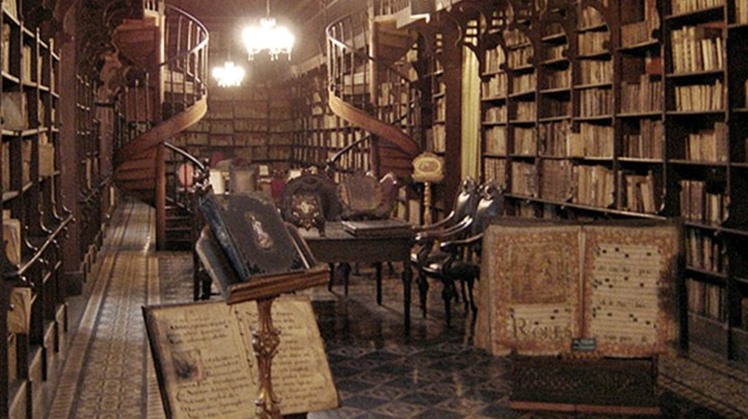Archaeologist Dr. Abdul Rahim Rayhan, Director General of Research, Archaeological Studies and Scientific Publishing in the regions of archeology of South Sinai, confirmed that the library of the Monastery of St. Catherine is the second in the world after the Vatican Library in terms of the importance of its manuscripts as it includes 4,500 manuscripts of the most important manuscripts in the world.
Rehan said - in a statement to the Middle East News Agency on Saturday - that among those manuscripts are 600 Arabic manuscripts, in addition to the one thousand scrolls in the Arabic language, explaining that there are also 2319 Greek manuscripts, 284 Latin manuscripts, in addition to the Syrian, Coptic, manuscripts. Abyssinian, Amharic, Slavic, Armenian, English, French and Polish.
He added that these manuscripts are religious, historical, geographical and philosophical ... explaining that the oldest manuscripts date back to the fourth century AD and some of these manuscripts were written in the Sinai and some of them are from Palestine, Syria, Greece and Italy, and some of them carry the names of transcribers without reference to a place such as Suleiman Shamas, George and Nicholas in the century 12th and 13th century AD.
The archaeologist pointed out that there is a library of the Monastery of St. Catherine, a thousand documents in the form of scrolls bearing the development of Diwani Arabic calligraphy between the 12th and 19th centuries CE. Year 331 AD.
He continued that he maintains the library of the Syriac Gospel known as (Palmpest), which is an incomplete written copy of the Bible in the Syriac language written on parchment Ghazal, it was said is the oldest known version of the Bible in the Syriac language.
He explained that there is in the library of the monastery (the prophetic covenant), which is the book of the covenant that was written for the monastery during the era of the Prophet of God Muhammad, peace and blessings be upon him, and it is the covenant in which the Messenger of God, peace and blessings be upon him, insures the people of the book on their money, themselves and their properties, and the library also contains a number of firmans from the caliphs Muslims to secure the people of the book.
Dr. Rayhan confirmed that the study of Saint Catherine Monastery documents began in the 1950's when a joint scientific mission from the Faculty of Arts in Alexandria and the American Library of Congress photographed the most important manuscripts and documents, and on top of this mission was Dr. Abdel Hamid El-Abady, the first dean of Alexandria literature and Dr. Aziz Sorial Attia, and the mission made photos Microfilm for the most important of these icons.
He said that in 1963 the mission of Alexandria University, headed by Dr. Ahmed Fikry and shared by Dr. Joseph Nissim Youssef, who visited Sinai twice late in 1963, these missions resulted in studies and research published in scientific journals, and among these researchers are Kurt Weizmann, George Forsyth and Aziz Sorial Attia who undertook indexes Complete with an analytical study of Arabic manuscripts in the monastery.
Rayhan pointed out that a million copies of 5,000 manuscripts and documents written in 12 languages were photographed. The Faculty of Arts at the University of Alexandria and the Library of Congress in Washington have kept copies of microfilm pictures.
He noted that the Ministry of Tourism and Antiquities has carried out restoration and development work for the eastern part of the library, and in December 2017, Dr. Khaled Al-Anani, Minister of Tourism and Antiquities, opened the first stage of the development and the second phase is being implemented.
Rehan called for good use of the library after its development by signing a cooperation protocol between the Ministry of Tourism and Antiquities and the Bibliotheca Alexandrina in a national project to digitize the manuscripts of the library to make it available to researchers because of the high-tech library in Alexandria in this field to start with the manuscripts in the Arabic language followed by the rest of the manuscripts, and after that it includes a website Especially after digitizing it and making it available to all researchers especially with the lack of studies in the Arabic language of the manuscripts of the Monastery of St. Catherine Library since 1959 due to the difficulty of accessing it, which deprived the Arab Library of important studies that confirm the values of civilizational coexistence between religions and civilizations and civilizational and cultural relations between Egypt and all countries of the world.
He explained that the Arabic manuscripts in the monastery include Christian and Islamic manuscripts written in the Arabic language, and the most important thing that draws attention in most of the Christian manuscripts that were written in the Arabic language is the presence of Arab-Islamic influences in it, after Sinai and its monastery and its monuments became subordinate to the Arab Islamic sovereignty, where we find that many of the Arab Christian manuscripts It begins with Basmalah, concludes with praise to God, and chronicles the Hijri calendar, and the examples are many, as the books of the Bible begin with Christians in many manuscripts, as follows (In the name of God, the Most Gracious, the Most Merciful. We begin with God’s help and write the first book), and many Christian apostles and saints are called (Mustafa) Instead of the word Al-Bashir or the Evangelist, many of these manuscripts were embellished and covered with inscriptions, drawings and motifs in the form of birds, flowers, botanical leaves and frames in Arabic script.
 Sun, May. 31, 2020
Sun, May. 31, 2020